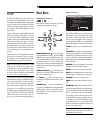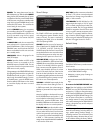
33
English
• Five LARGE speakers and sub-
woofer: This system requires no bass re-
direction. All five speakers play the nor-
mal bass recorded in their respective chan-
nels. The subwoofer plays only the LFE
channel bass. Depending on the
soundtrack, there may be minimal use of
the LFE channel, so the subwoofer would
be under utilized. Meanwhile the normal
bass places higher demands on the capa-
bilities of the other speakers and the am-
plifiers driving them.
• LARGE front, center, surround
speakers, no subwoofer. The normal
bass from the front, center, and surround
channels is played in its respective speak-
ers. With no subwoofer, the LFE bass is re-
directed to all five LARGE speakers. This
places significant demands on these speak-
ers and their amplifiers, as they must play
their own normal bass plus the very demand-
ing LFE bass.
• All SMALL speakers and subwoofer.
The normal bass from all channels is redi-
rected to the subwoofer, which also plays
the LFE channel. The subwoofer handles
ALL of the bass in the system. This configu-
ration provides several benefits: deep bass
is played by the speaker most suited to do
so, the main speakers may play louder with
less distortion, and the need for amplifier
power is reduced. This configuration should
be used with bookshelf-size or smaller main
speakers. It should also be considered in
some cases with floorstanding front speak-
ers. This configuration is advantageous
when driving the system with moderate
power amplifiers.
• LARGE front speakers, SMALL cen-
ter and surround speakers, and a
subwoofer. The normal bass from the
SMALL center and surround speakers is re-
directed to the LARGE front speakers and
the subwoofer. The LARGE front speakers
play their own normal bass plus the redi-
rected bass from the SMALL speakers and
LFE bass. The subwoofer plays the LFE bass
plus the redirected bass from all of the other
channels. This might be an appropriate con-
figuration with a pair of very capable front
speakers driven by a large power ampli-
fier. A potential disadvantage with mixed
LARGE and SMALL configurations is that
the bass response may not be as consis-
tent from channel to channel as it might
be with the all SMALL configuration.
NOTE
: As an alternative configuration with a
satellite/subwoofer package as the front
speakers, follow the speaker manufacturer’s
instructions, connecting the high-level inputs
of the powered subwoofer directly to the front
speaker outputs of the RSP-1098 and con-
necting the satellites to the subwoofer’s own
crossover. In this arrangement, the speakers
would be classified as LARGE and the sub-
woofer setting would be OFF for all surround
modes. No information is lost during play-
back because the system redirects bass infor-
mation to the front LARGE speakers. While
this configuration ensures proper satellite
speaker operation by using the speaker’s own
crossovers, it has some disadvantages in terms
of system calibration and would generally not
be the preferred configuration.
Speaker Setup
SPEAKER SETUP
FRONT:Large
CENTER:Large
SURROUND:Large
CENTER BACK:Large1
SUBWOOFER:Yes
ADVANCED:Enter
MAIN MENU
The SPEAKER SETUP menu is used to config-
ure the RSP-1098 for use with your specific
loudspeakers and to determine the bass man-
agement configuration as described in the
previous overview. The menu is accessed from
the MAIN menu.
The following speaker options are available:
FRONT SPEAKERS (small/large): Use the
LARGE setting to have the front speakers play
low bass (full-range). Use the SMALL setting
to redirect normal bass away from these speak-
ers to a subwoofer (high-pass filtered).
CENTER SPEAKER(S) (large/small/
none): Use the LARGE position (not available
with SMALL front speakers) to have the cen-
ter speaker play low bass (full-range). Use the
SMALL position if your center channel speaker
has limited low frequency capability, or if you
prefer that the bass be sent to the subwoofer
(high-pass). Select the NONE setting if your
system does not have a center channel speaker
(the surround modes will automatically divide
all center channel information equally between
the two front speakers, creating a phantom
center channel).
SURROUND SPEAKERS (large/small/
none): Select the LARGE setting (not avail-
able with SMALL front speakers) to have the
surround speakers play low bass (full-range).
If your rear speakers have limited bass capa-
bility or if you would prefer that the bass go
to a subwoofer, use the SMALL setting (high-
pass). If your system has no rear surround speak-
ers, select the NONE setting (surround chan-
nels are added to the front speakers so none
of the recording is lost).
CENTER BACK SPEAKER(S) (large1/
large2/small1/small2/none): Some
systems have one or two additional center back
surround speakers. Select the LARGE settings
(not available with SMALL front speakers) to
have your center back speaker(s) play low bass.
Use LARGE 1 if you have one center back
speaker (6.1) or LARGE 2 (7.1) if you have
two center back speakers (7.1). If your cen-
ter back speakers have limited bass capabil-
ity or if you would prefer that the bass go to
a subwoofer, use the SMALL setting (SMALL1
for one speaker, SMALL2 for two speakers).
If your system has no center back speakers,
select the NONE setting. With center back
speakers, the Rotel XS eXtra surround, Dolby
Digital EX, DTS-ES, Dolby Pro Logic II, DTS
Neo:6 or other decoders will provide center
back signals for any surround mode.
SUBWOOFER (yes/no/max): The YES set-
ting is the standard setting if your system has
a subwoofer. If your system does not have a
subwoofer, select NO. Select the MAX setting
for maximum bass output with normal bass
being duplicated by both the subwoofer and
any LARGE speakers in the system.
ADVANCED: Speaker configuration is gener-
ally a global setting for all surround modes
and need only be done once. However, for
special circumstances, the RSP-1098 provides
the option of setting the speaker configuration
independently for each of four surround modes.
Select the ADVANCED line on the menu and
press ENTER to go to the ADVANCED SPEAKER
SETUP menu described in the following sec-
tion.


















